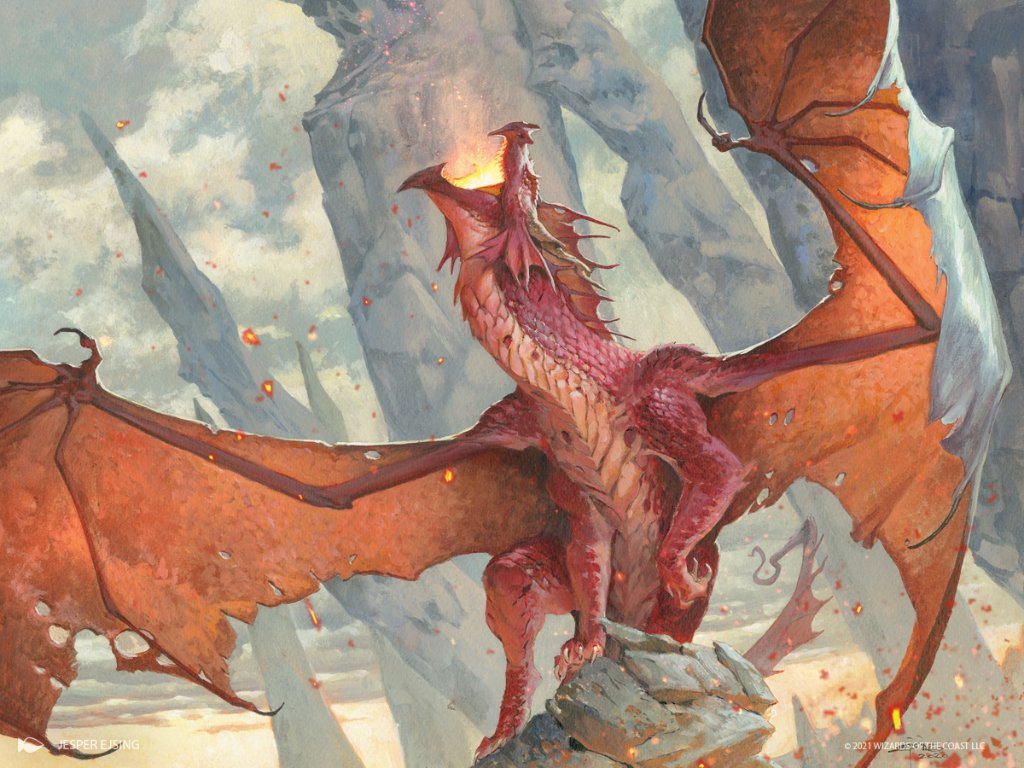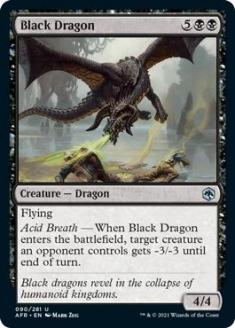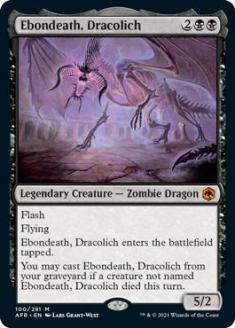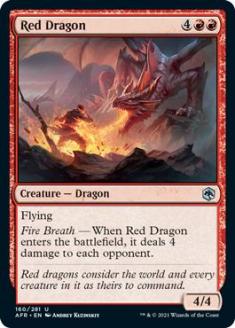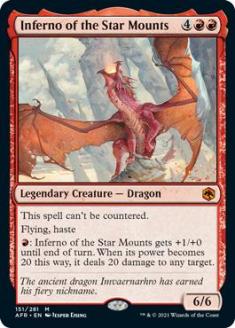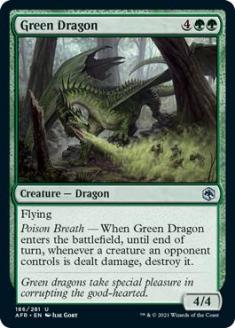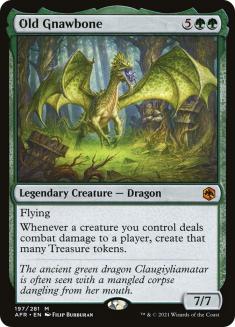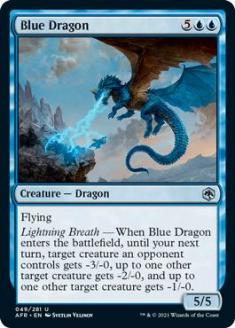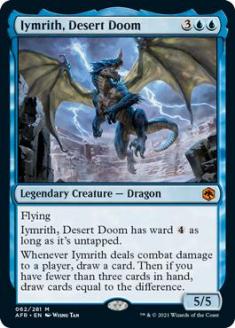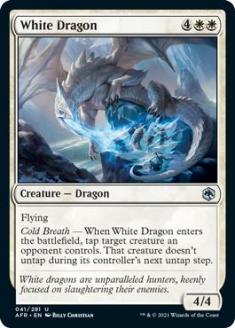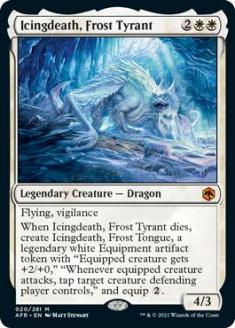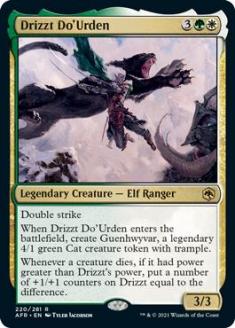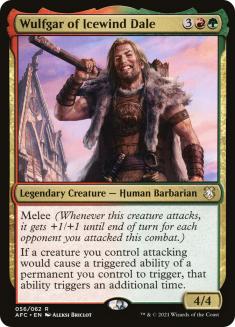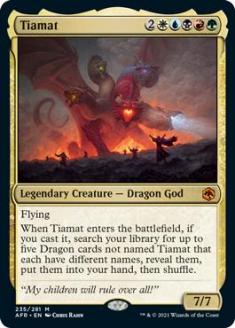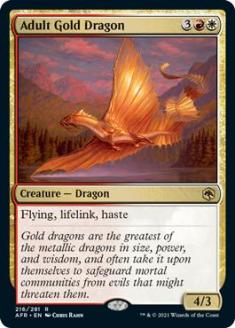Welcome back, adventurer! You are beginning to earn quite the reputation here! As always, there are matters to discuss; I have a quest for you to undertake. A terrible creature is terrorizing the countryside and it needs to be dealt with, but this is no mindless beast! Tell me adventurer… have you ever faced a dragon?
Earlier this week, we discussed some of the legendary creatures and planeswalkers. In this section we are talking about some of the most fearsome foes to ever walk (or fly) across the Forgotten Realms — Chromatic Dragons! These creatures have an innate need to hoard treasure in their lairs and possess innate magic that literally changes the landscape around them to better suit the dragon’s lair. I love dragons, especially in D&D. They’re tough predators who aren’t mindless beasts but intelligent creatures and are often the final boss at the end of the dungeon. As a player, you always remember your first battle with a dragon! Dragons are also long-lived, cunning planners who can live for thousands of years and present interesting roleplaying challenges for players to interact with.
The neat thing about chromatic dragons in Adventures in the Forgotten Realms is that they are represented as a generic dragon card and as a named legendary creature which is also a representative of that type of chromatic dragon. Most of the dragons are depicted by the titles given to them by mortals as most draconic names are nearly unpronounceable. The chromatic dragons of Dungeons & Dragons also sync up perfectly with the five colors of Magic: the Gathering. In this article, we will also be discussing Tiamat, the Queen of Evil Dragons, who is the mother of all chromatic dragons.
Black Dragon
Black dragons are chromatic dragons who possess an evil temperament and unsavory practices. They make their homes in the ruins of ancient kingdoms, often in foul-smelling marshes and swamps. Black dragons are also aquatic and can breathe water as easily as air. As its name implies, black dragons have black scales and a skeletal face with distinctive curved horns that sweep forward beyond its cheeks. As they age, they take on an even more fearsome countenance; their features take on an even more spiky and skeletal appearance as their signature acid breath seemingly dissolves their softer features. Chromatic dragons are usually evil by nature, but black dragons take cruelty and malice to a whole new level. They delight in the pleading screams of their victims. Black dragons breathe acid on their victims and often attack the weakest enemies first. Defeating weaker foes boosts its ego. After finally finishing off a kill, black dragons will often leave it to rot and “pickle” in their bogs as they prefer the taste of rotten meat and enjoy how the rotting flesh fouls the water around their lair.
How does the Black Dragon card measure up? Black Dragon is a black creature with flying and the following ability:
As a true dragon, Black Dragon has both a breath weapon and the ability to fly and is a substantial creature with good power and toughness represented in the card. It’s also suitably cruel and picks on a small creature with its breath weapon. I also love the flavor text at the bottom of the card:
Black dragons revel in the collapse of humanoid kingdoms.
I think this gives a good feel for how cruel these swamp dwelling dragons are.
Grade: A
Ebondeath, Dracolich
Ebondeath (or Chardansearavitriol as was his actual draconic name) was once a black dragon who underwent a ritual to become a dracolich. A dracolich is a mighty undead dragon created by a powerful necromantic ritual. Creating a dracolich requires the cooperation of several powerful spellcasters. The dragon willingly consumes a potion that instantly slays it, while the spellcasters weave a spell to ensnare the dragon’s soul and bind it to a magical gem that acts much like a lich’s phylactery. The flesh of the dragon sloughs away, leaving a gruesome skeletal dragon. If the dragon’s physical form were ever destroyed, and the magic gem were to be brought into contact with another dragon corpse, it would possess the body and reanimate.
Ebondeath was worshiped by a sect of the Cult of the Dragon, an evil cult devoted to the worship of dragons and the creation of dracoliches. Ebondeath made his home in the Mere of Dead Men in the mausoleum under the Uthtower. Ebondeath was disintegrated into dust by the god Myrkul, but as his spirit is still tied to his remains, he could quite literally rise from the ashes again!
Ebondeath is a very powerful card, but how does it measure up from a flavor perspective?
Ebondeath, Dracolich is a black legendary Zombie Dragon with flash and flying. It has high power and low toughness, reflecting its fragile nature. It also, unlike any of the other dragons in this set, has a powerful way to recur the creature when another creature dies:
You may cast Ebondeath, Dracolich from your graveyard if a creature not named Ebondeath, Dracolich died this turn.
The recursion ability is powerful and reflects Ebondeath’s ability to return from beyond the grave if his magical gem is brought in contact with another dragon’s corpse. I realize they wanted to make the card powerful, but a more flavorful choice might have been “whenever another Dragon dies.” But this is my only quibble with the card; otherwise it’s great!
Grade: A-
Red Dragon
Arguably the most powerful of the chromatic dragons, and my favorite, red dragons are some of the most fearsome foes to take to the skies of the Forgotten Realms. Their swept-back horns and distinctive head fin, coupled with their beautiful crimson scales, give them an almost regal bearing. It’s clear that they know how powerful they are as they believe themselves to be above all other creatures. In fact they believe themselves chosen by Tiamat herself to rule over all living creatures.
The arrogance of red dragons seemingly knows no bounds. They are capricious by nature and can fly into a fiery tantrum on a whim. Fortunately for the people of the Forgotten Realms, red dragons are territorial and tend to live in isolated mountainous regions away from other dragons, including their own kind. However, red dragons often rely on well paid informants, spies, and other associates to keep them apprised of the events of the outside world.
A red dragon’s lust for golden treasure is insatiable and their treasure troves tend to be mountainous. It is said that they can weigh the value of any given treasure and know where each and every coin is within its massive treasure trove. Furthermore, legend states that the loss of a single coin could cause the dragon to fly off in a murderous rage, hunting the thief across the land to return the stolen item. The fire-breathing red dragon has one of the most powerful breath weapons in D&D which can be lethal to a group of under-prepared adventurers.
How does the card stackup? Red Dragon is a red creature with flying with the following ability:
The Red Dragon does not mess around and attacks its opponents directly, unconcerned with the creatures below it that it likely deems as inconsequential. I would have loved to see this card have an effect similar to Searing Blaze where it dealt 3 damage to a creature and 3 damage to a player to represent the power of the mighty dragon, but it is still flavorful. My favorite is the flavor text, which fully encapsulates the arrogance of these powerful dragons.
Red dragons consider the world and every creature in it as theirs to command.
Grade B+
Inferno of the Star Mounts
Imvaernarhro, often referred to as Inferno by the people of the Forgotten Realms, has a lair in the Star Mounts, is a powerful ancient red dragon, and master of fire magic. You read that right. In D&D, dragons are often innate spell casters and given their long lifespans they have the time to truly master the schools of magic as Inferno has. In typical red dragon fashion, Inferno is an isolationist and keeps mostly to themselves; however, they have recently begun to cast their covetous eye upon the Silvery Marches. It is said that Inferno’s grand treasure hoard is spread across the peaks of the Star Mounts, hidden in caverns and caves throughout the mountain chain. According to Elminster, Inferno’s treasure hoard is worth tens of millions of gold coins.
So how does Inferno’s card measure up? Let’s take a look! Inferno of the Star Mounts is a legendary red Dragon. They also have the following abilities:
Flying, haste
{R}: Inferno of the Star Mounts gets +1/+0 until end of turn. When its power becomes 20 this way, it deals 20 damage to any target.
One of the spells that mages learn relatively early is how to identify and counter a spell. Inferno. being a master of magic, likely learned how to do this as well, therefore, resulting in this ability. They are also a red dragon which are known for their aggressive nature, so flying and haste make sense here. Its final ability is what is really powerful and flavorful here. Inferno, master of fire magic, is able to manipulate its own fire breathing and blow away any resistance!
This card is the epitome of a red dragon. I personally really like this card. I think the design is really cool and flavorful. I plan to build an Inferno of the Star Mounts Commander deck, as I can’t pass up being able to control such a cool and powerful dragon!
Grade: A
Green Dragon
Scheming and treachery are the tools of the green dragon. These dragons love nothing more than to corrupt the pure of heart. Unsurprisingly, these mighty creatures are renowned silver-tongued liars and masters of manipulation. They are especially fond of bending creatures to their will, particularly mortal heroes and figures of importance. These dragons also find it delightful when they’re able to corrupt and manipulate elves. The elves who they are unable to manipulate, they consume. As opposed to other dragons, these master schemers prefer to “collect” mortals which have been bent to their will. The more famous and influential the better. Like other dragons, they do collect and hoard other items of value.
Green dragons have emerald green scales that help them blend in with their woodland home. They also have a distinctive fin that runs from the top of their head to the back of their tail. Like their black dragon cousins, green dragons are also amphibious and often make their home near lakes and ponds or behind waterfalls where the entrance to their lair can be properly submerged. In disputes with other dragons, including their own kind, green dragons will feign cowardice, sometimes for decades, while they assess their rival and await an opportune time to strike. In combat, green dragons have a powerful poison breath weapon that they use to kill their enemies.
Now, let’s take a look at the card! Green Dragon is a green creature with flying with the following ability:
This is a pretty strong ability and a neat design. The card evokes the sudden descent of a dragon, breathing poison across an opponent’s battlefield just before its allies attack. The flavor is further exemplified with its flavor text:
Green dragons take special pleasure in corrupting the good-hearted.
Grade: B
Old Gnawbone
Claugiyliamatar, or Old Gnawbone, is a powerful green dragon who lives in Kryptgarden Forest which she claims as her own personal hunting ground. Old Gnawbone’s nickname is well earned as she has a habit of gnawing on old kills and is often found with the maimed skeletal remains of her unfortunate victims hanging from her powerful jaws. This solitary dragon is very protective of her hunting grounds and constantly drives out any dragons who come upon her territory. In the past, Old Gnawbone tried to bend the cities of both Waterdeep and Neverwinter to her whim and earned the enmity of a Waterdhavian noble house when she, under the guise of a silver dragon, tricked them into paying the dragon for protection from herself, stole the promised payment, and then demanded even more treasure when the noble couldn’t pay up. T
he city of Waterdeep responded by trying to kill Old Gnawbone and ended up killing one of her rivals instead. Wow! What a con! And a fall-dragon!
Nowadays, Old Gnawbone keeps pretty much to herself, rarely affecting the lives of mortals, but she does keep up-to-date on the latest happenings via her collection of crystal balls. She can be found in the module Storm King’s Thunder where she may offer players some useful advice. Or maybe she will just eat them!
Now that we know a little about Old Gnawbone, let’s take a look at her card! Old Gnawbone is a green legendary Dragon with flying and the following ability:
This is a clear reference to her conning of the nobles of Waterdeep and shows just how cunning the ancient dragon is. I also love the flavor text:
The ancient green dragon Claugiyliamatar is often seen with a mangled corpse dangling from her mouth.
For me, this card is the perfect marriage of power and flavor [and Old Gnawbone didn’t even pay me to say that]!
Grade: A
Blue Dragon
As their name suggests, blue dragons have blue scales which crackle and hum with electricity. The area around the dragon’s lair reeks of ozone and thunderstorms often rage nearby. Blue dragons are normally found in arid climates such as badlands, deserts, coasts, and steppes. These desert-dwelling dragons are extremely territorial and incredibly vain. A blue dragon will suffer no insults, especially if the individual insinuates it is weak.
Even though they’re vain, blue dragons are patient and calculating, attacking on their own terms whenever they can. They turn battles into strategic battles of attrition. Blasting their enemies with their powerful lightning breath before flying safely out of reach. The breath of a blue dragon emanates as a line of lightning that is longer and does more damage the older the dragon. Blue dragons have a distinctive horn atop their head that they use to burrow into the ground or sand where they await to ambush their prey.
Unlike other dragons, blue dragons have a rigid hierarchy that they follow in the desert, with themselves at the top of this hierarchy (naturally). The eldest and most powerful dragon settles disputes and the rest of the dragons pay homage to this elder dragon. Blue dragons also surround themselves with talented minions (which serves to swell their already tremendous ego); they reward these minions handsomely for their service.
Now that we know a little more about blue dragons, how does their card compare? Blue Dragon is a blue creature with flying and the following ability:
It’s clear that this is depicting the blue dragon’s breath weapon hitting three creatures and weakening them for a turn. I would have liked to see the breath weapon do actual damage to creatures but this ability is still pretty on brand for a blue dragon. This ability is pretty long and leaves little room for flavor text though.
Grade: C+
Iymrith, Desert Doom
Major spoilers for Storm King’s Thunder here so be warned! Iymrith is the primary antagonist of the module Storm King’s Thunder. The wily ancient blue dragon, who can assume the form of a storm giant, has wormed her way into the court of King Hekaton. Through the manipulation of Hekaton’s daughters Mirran and Nym, Iymrith has orchestrated the assassination of Queen Neri and the disappearance of King Hekaton as she single handedly seeks to throw the world of giants (the ancient enemies of the dragons) into chaos and infighting.
Iymrith is the final villain in the campaign and the players will encounter her in her lair deep within the desert. The final chapter of the module is entitled: Doom of the Desert. This is Iymrith’s well-earned title. As an ancient blue dragon, Iymrith is so powerful that the players cannot fight her without the aid of several storm giants and even then, the results of the ensuing battle are anything but certain.
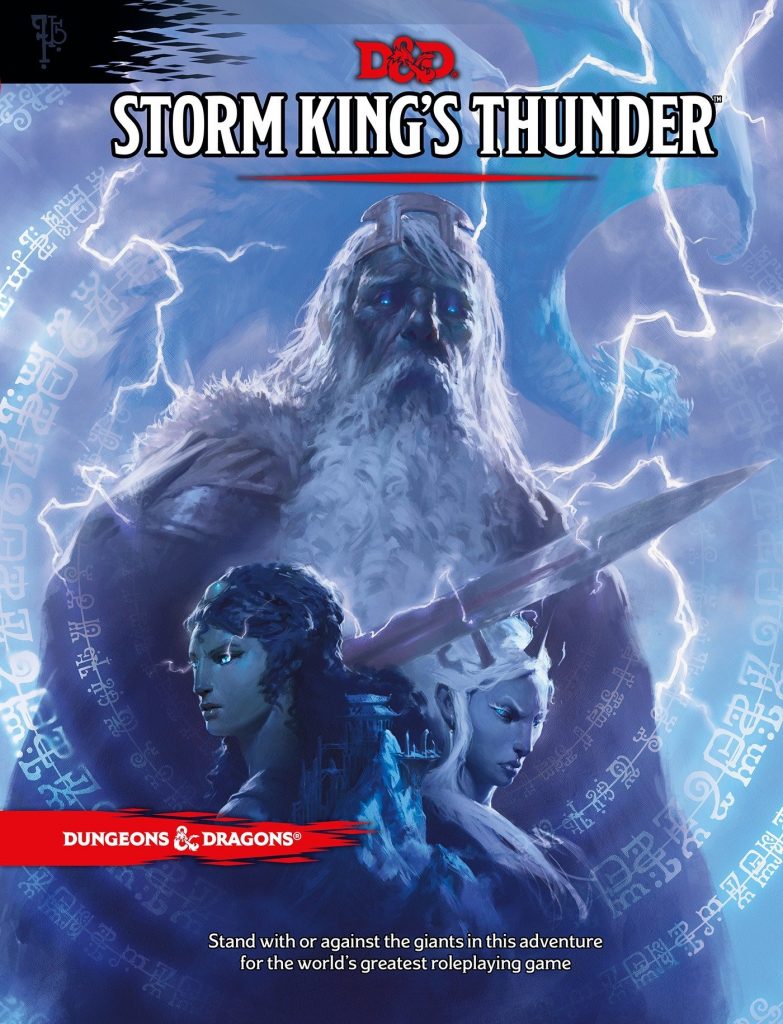
How does her card stack up? Iymrith, Desert Doom is a blue legendary dragon with flying. She is also wickedly clever and a master schemer which is evidenced as she single-handedly orchestrated the downfall of an entire civilization.
Whenever Iymrith deals combat damage to a player, draw a card. Then if you have fewer than three cards in hand, draw cards equal to the difference.
So long as Iymrith is in her Storm Giant guise, it’s difficult to tell that she’s truly a villain. As a potent spellcasting dragon, Iymrith is also well adept at spellslinging which reflects her second ability. I think these abilities are powerful, no question, but I believe that they could have been more flavorful. Perhaps she would turn into a giant and lose flying but gain hexproof or some such. I wanted a little more from this card.
Grade: B-
White Dragon
White dragons are powerful hunters who lack the subtlety and scheming of other dragons. Nearly feral compared to their other chromatic cousins, white dragons more than make up for their lack of subtlety with their instincts and brutality. The scales of a white dragon are white and become mottled with age to provide better camouflage for the gargantuan predator. They are identified by their short sharp beak and short fin-like crest atop their head. White dragons like their food cold and will use their powerful cold breath to freeze the life from their victims. Larger and more powerful foes that are frozen solid are displayed in their caves as a warning to would-be interlopers. They also freeze their treasure hoards under layers of ice which would take normal adventurers hours to chip through but which the dragon with its powerful claws can accomplish in mere minutes. White dragons prefer solitude and make their lairs high in the mountains of colder arctic regions.
Let’s take a look at the card. White Dragon is a white creature with flying and the following ability:
I think this ability falls a little short, as white dragons famously freeze their prey and set them out on display. I think I would have made the ability something like:
I think this may have represented the dragon’s attack better and fits within the white mana purview. The flavor text also does a good job of describing the savagery of these arctic predators:
White dragons are unparalleled hunters, keenly focused on slaughtering their enemies.
Grade: B-
Icingdeath, Frost Tyrant
Ingeloakastimizilian, or Icingdeath as he was known to the denizens of Icewind Dale, was a powerful white dragon who lived in the far reaches of Icewind Dale in a region of hot springs known as Evermelt. Icingdeath rarely left his ice-covered treasure hoard. In R.A. Salvatore’s The Crystal Shard, Wulfgar was tasked with returning with a mighty trophy that he might use to challenge the leader of his tribe to unite the Barbarians against a common foe. Icingdeath was eventually killed by Drizzt Do’urden and Wulfgar when Wulfgar threw his mighty hammer, Aegis-fang, into a colossal icicle which fell, impaling and felling the mighty dragon.
From this treasure hoard, two notable treasures were taken. The first was the mighty dragon’s horns, proof of Wulfgar’s triumph and his right of challenge. The second was a magically enchanted scimitar, claimed by Drizzt, which came to bear the name of the mighty dragon.
Let’s take a look at Icingdeath, Frost Tyrant. What a title! He’s a white legendary dragon with flying and vigilance. As Icingdeath rarely left his treasure hoard, the vigilance makes sense — he would be keenly aware of any invaders. Unlike other white dragons, he is clearly depicted with horns, which are later taken by Wulfgar. His second ability is the most flavorful in my opinion:
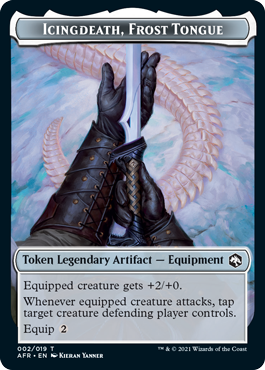
This is a reference to Drizzt’s famed scimitar in which you can see Drizzt holding the weapon for the first time and you can see the tail of the defeated dragon in the background of the token. The token also gives an effect similar to White Dragon’s Cold Breath ability which is on brand with the weapon.
Icingdeath, Frost Tyrant and it’s associated token is *chef’s kiss* Perfect!
Grade: A+
Before we get into the Queen of evil Dragons, and the one lonely Metallic Dragon, I wanted to take a moment to give my assessment of the dragons of this set. I feel that the non-legendary versions of the dragons were pretty flavorful, but the legendary representatives of the dragons did a much better job of encapsulating the flavor of the chromatic dragons over all.
Tiamat
The Dragon Queen, Bane of Bahamut, Creator of Evil Dragonkind. The evil dragon goddess Tiamat has many titles and is the antithesis of her brother Bahamut, the god of goodly dragons. Depicted as a colossal five-headed dragon, with one head of each of the chromatic dragons (white, blue, black, red, and green), Tiamat is truly terrifying to behold. Currently imprisoned in Avernus for a contract whose details are known only to Tiamat and Asmodeus (man that guy really gets around, huh?).
She nearly escaped her imprisonment from Avernus and is the primary antagonist of the module Rise of Tiamat. In the module, the players must work together to collect allies and stop the cult of the dragon from freeing Tiamat who, if she escapes, will deliver unholy draconic punishment across the Forgotten Realms. The players fight Tiamat when she is in a weakened state. If they fought this deity at the height of her power, she could squash them easily. She has the ability to make use of each of the draconic breath weapon attacks, has limited magic immunity, and can cast powerful spells at will.
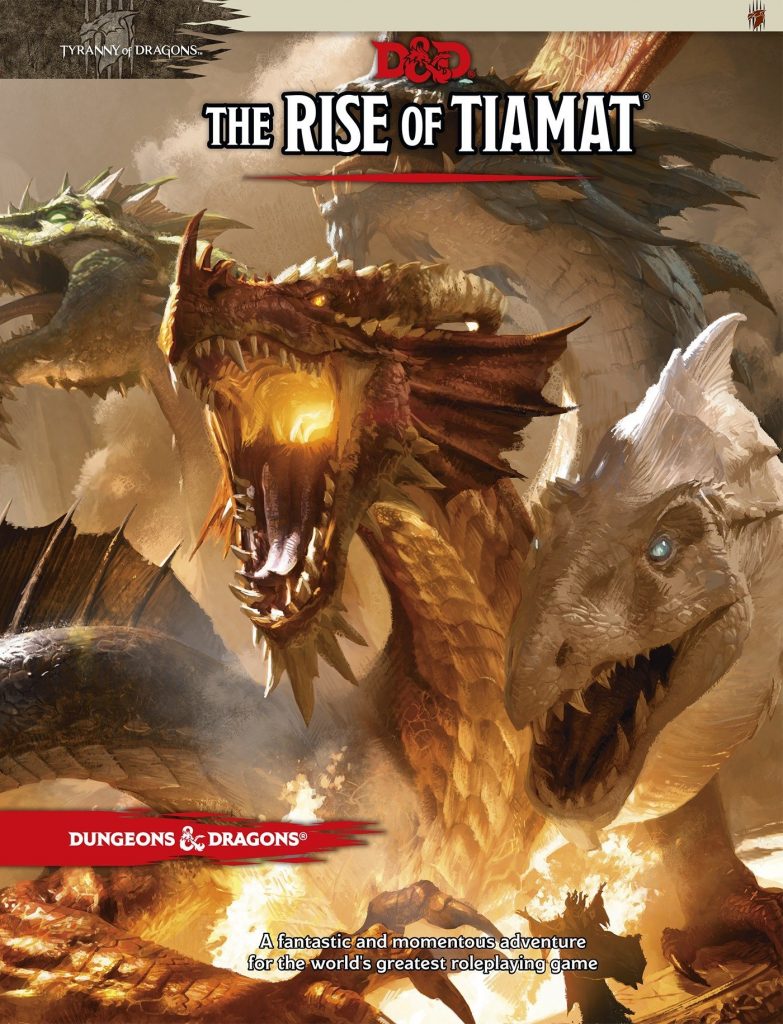
So how does the dragon goddess’s card measure up to the near legendary status? I will say now that I had to temper my expectations because any representation of this goddess is either going to end up game-breaking or disappointing. Tiamat is a multicolored legendary Dragon God befitting her deific status. As with the rest of her brood, Tiamat has flying and the following ability:
I also really like her flavor text and how it fits with her ability: “My children will rule over all!” The neat thing is that you get to search up a dragon for each of her heads and if you were playing the dragons from this set, you could search up one of each of the evil chromatic dragons.
Another cool thing is that she has the same power and toughness as her brother Bahamut, making them true rivals. I think the card is a good depiction of an iconic villain who is incredibly powerful. However, I would have at least made her indestructible given her status as the dragon goddess.
Grade: B
A Note On Metallic Dragons
One note on metallic dragons, as they are noticeably absent from the set sans Bahamut (kind of) and Adult Gold Dragon. Missing here are silver, copper, bronze, and brass dragons. These are goodly dragons who are usually kind-hearted and would likely be multicolored dragons and would likely include the color white as their primary color. We also did not get any metallic dragon legendary creatures in the set which is disappointing; however, I have hope that this set is only the first of many and that we will see metallic dragons swoop in from on high to surprise us with neat abilities and interactions. How long we will have to wait before this happens I cannot say but I think it is a pretty safe bet that we will see them in the future!
I’m also excited to see everything that comes out of the newest Dungeons & Dragons sourcebook: Fizban’s Treasury of Dragons! It is sure to include updated information on chromatic dragons, metallic dragons, and, judging by the cover, gem dragons! Perhaps we will even have some updated information on some of the named legendary dragons that cast their shadow across the Forgotten Realm!
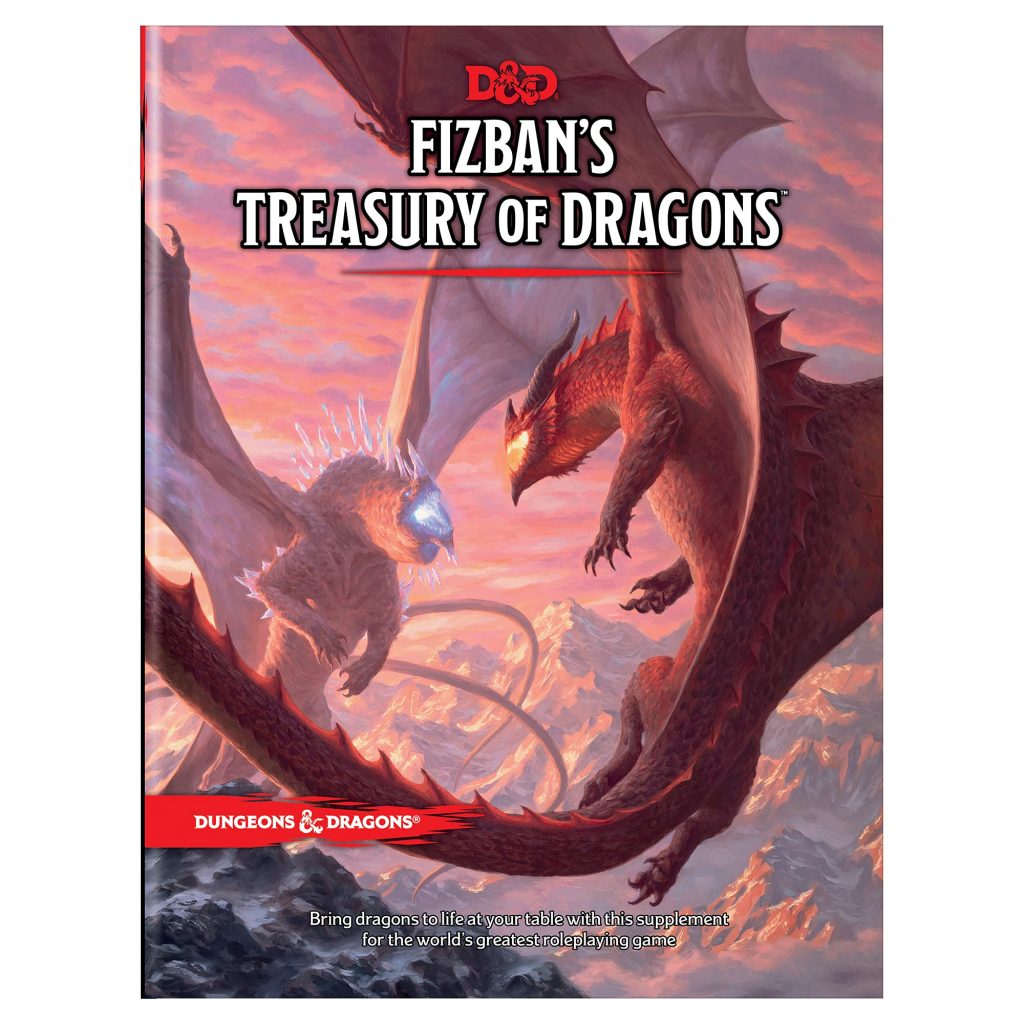
I hope you enjoyed this article. It was truly a labor of love. If you are a Dungeons & Dragons fan like myself and want to read more of my musings about dungeons, dragons, and Game Master advice, check out my blog.
So what did you think of my assessment of the flavor of these cards? What is your favorite Dragon creature from Adventures in the Forgotten Realms?

